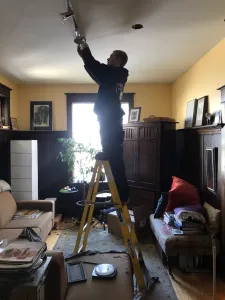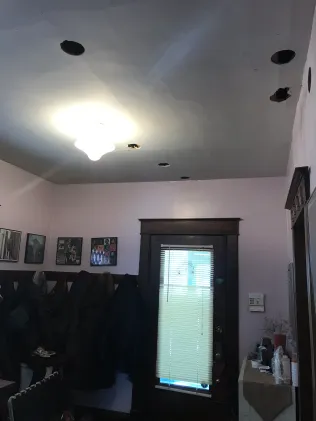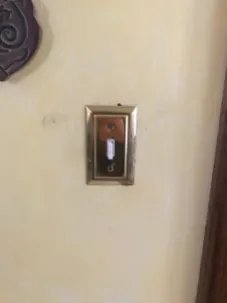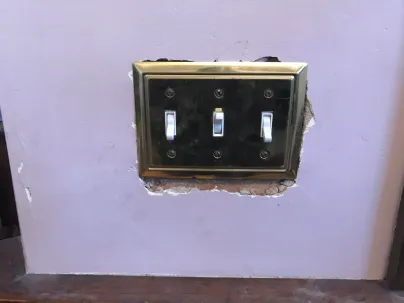Knob and Tube Removal in Winnipeg: What to Expect and How to Prepare
- Buffy Davey
- Mar 15, 2018
- 4 min read
What to expect?
There is a large market for knob and tube removal in Winnipeg and a relatively low level of expectations. What does it look like? How invasive will it be? How messy will it be? How long will it take? So many questions, and often questions we can’t answer in the initial meeting to set you up to know what you’re getting into.
To start, removing Knob and Tube it can be quite invasive. It requires pulling new wires to every electrical outlet in the house. Sometimes there are areas that are already rewired, but for the most part everything is opened up and supplied with new 14/2 NMD90.
In a perfect situation we, the electrician, are coordinated to do the work when the home is first purchased or just about to be sold. When there is no furniture in the house it allows us to get the work done a little bit faster, and have a much easier clean up. Sometimes insurance requires it to be rewired to maintain coverage, in which case there is more of a time constraint and other living accommodations aren’t always available. In which case we do clean up at the end of each day (usually taking an average of 3-5 days for approximately a 1200 sq/ft, 2 storey home) and try to return as much power as possible while still keeping the the home safe. There will always be some areas during the construction that will not have power in the evening. As stated above, the work is quite invasive and therefore there is a decent layer of dust that will be present. We cover the areas we are working in with drop cloths, but its not practical to be able to cover everything in a fully furnished house during the process.
Knob and tube usually means the walls are lathe and plaster. Lathe and plaster is a way of construction before drywall which consists of small slats of wood run perpendicular to the studs and joists (hammered in with small nails) and then covered with a coating of plaster. This can make it difficult to create holes without creating more damage. We use a 4″ hole saw to cut all our holes used to fish wires, therefore whoever comes in to patch the work can use a 4″ hole saw on a new sheet of drywall for the patches. However, sometime the lathe comes loose when drilling and creates a bit more damage, as well as when we take out the existing boxes (primarily light switches and plugs) it can create a bit of damage around each outlet. The 4″ holes used for fishing are always kept to a minimum where possible and also we try to contain it to minimal areas (i.e. if we can make more holes in the front entry to avoid making holes in the living room one room over).
Other things to note:
Every bedroom requires a smoke detector and every floor requires a smoke/co detector.
Every plug in the house has to be changed to a tamper resistant plug.
It is usually assumed we are changing to a white decora style switch and plug unless otherwise told.
All plugs, with the exception of counter plugs, fridge plug, and sump plug are required to be arc fault protected.
Existing in floor plugs almost always have to be changed to a proper brass in floor box and cover.
If we can’t fish wires in an outside wall (about 50/50 whether we can or not) then an in floor box may be required.
All junction boxes need to be accessible, and if some exist that are covered we need to expose them to either have access to them or rewire so they won’t exist in that location.
We are currently only required to rewire the knob and tube outlets that are existing and not required to bring the quantities up to current code. However, the rest needs to be brought up to code (i.e. smoke detectors, tamper resistant outlets, arc fault circuits).
During this renovation if you are thinking of changing any light fixtures, now is a great time and required before the renovation starts (extra costs are incurred to return to hang new fixtures)
Any outlet within 1.5m of a sink needs to be GFCI protected.
Surprises can often come in an attic or in a basement when we start looking at things closer and realize newer wiring has been tied into knob and tube, or there is exposed NMD90 run on the surface of drywall and lower than 5ft, and many other “fun” surprises.
Basement stairs require a 3way switch controlling the lights of the stairwell from the top and the bottom.
Vermiculite “insulation” in an attic can contain asbestos. This style of insulation should be properly tested to ensure the safety of anyone working there, as well as you, the homeowner. Disturbed asbestos can be very hazardous.
There is always a lot to look for and a lot that can’t be found until we truly start digging. Free estimates are always available, but they are just estimates. Even opening a new device and seeing newer wiring, doesn’t mean it hasn’t been tied into knob and tube in a fashion that is not to code. So upon inspecting the wiring we usually assume all or most of the house needs to be rewired. The first day is often spent making sense of the spider web called knob and tube and getting a more firm quantity of outlets to be rewired. Surprises in a renovation are inevitable, but having better expectations of what your getting into when you need to rewire knob and tube is helpful for everyone involved.







